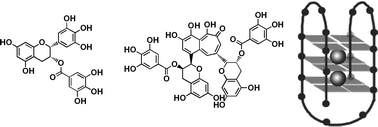Phenolic promiscuity in the cell nucleus – epigallocatechingallate (EGCG) and theaflavin-3,3′-digallate from green and black tea bind to model cell nuclear structures including histone proteins, double stranded DNA and telomeric quadruplex DNA†
Abstract
Flavanols from tea have been reported to accumulate in the cell nucleus in considerable concentrations. The nature of this phenomenon, which could provide novel approaches in understanding the well-known beneficial health effects of tea phenols, is investigated in this contribution. The interaction between epigallocatechin gallate (EGCG) from green tea and a selection of theaflavins from black tea with selected cell nuclear structures such as model histone proteins, double stranded DNA and quadruplex DNA was investigated using mass spectrometry, Circular Dichroism spectroscopy and fluorescent assays. The selected polyphenols were shown to display affinity to all of the selected cell nuclear structures, thereby demonstrating a degree of unexpected molecular promiscuity. Most interestingly theaflavin-digallate was shown to display the highest affinity to quadruplex DNA reported for any naturally occurring molecule reported so far. This finding has immediate implications in rationalising the chemopreventive effect of the tea beverage against cancer and possibly the role of tea phenolics as “life span essentials”.


 Please wait while we load your content...
Please wait while we load your content...